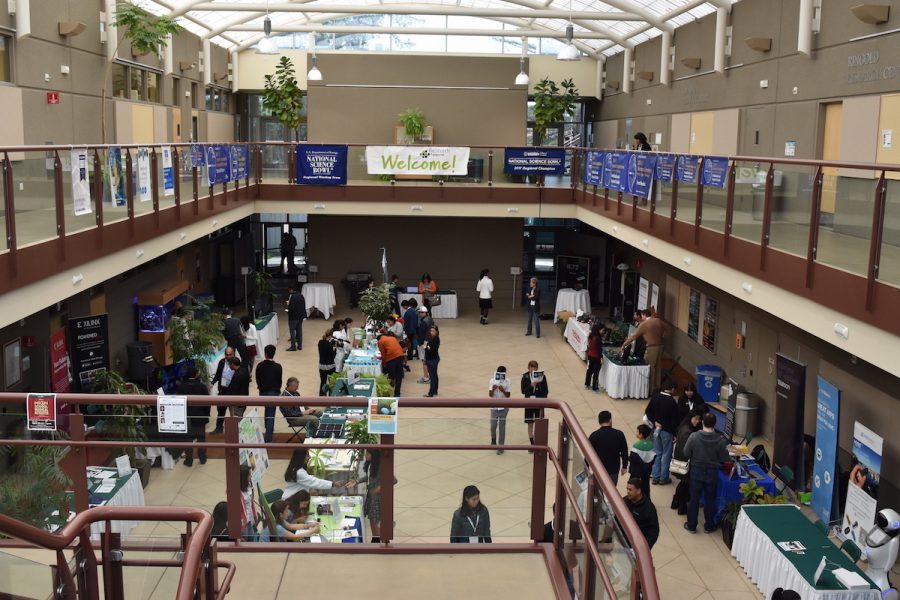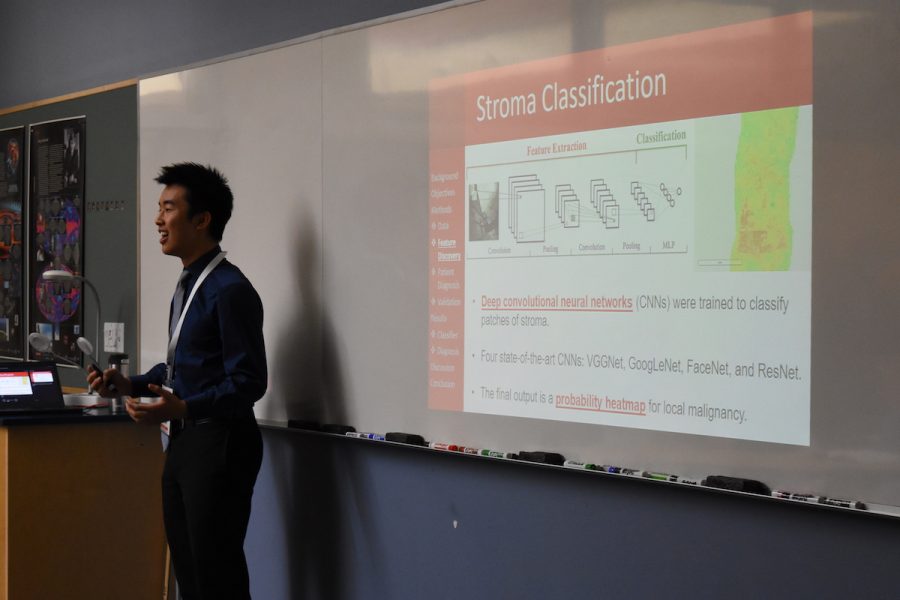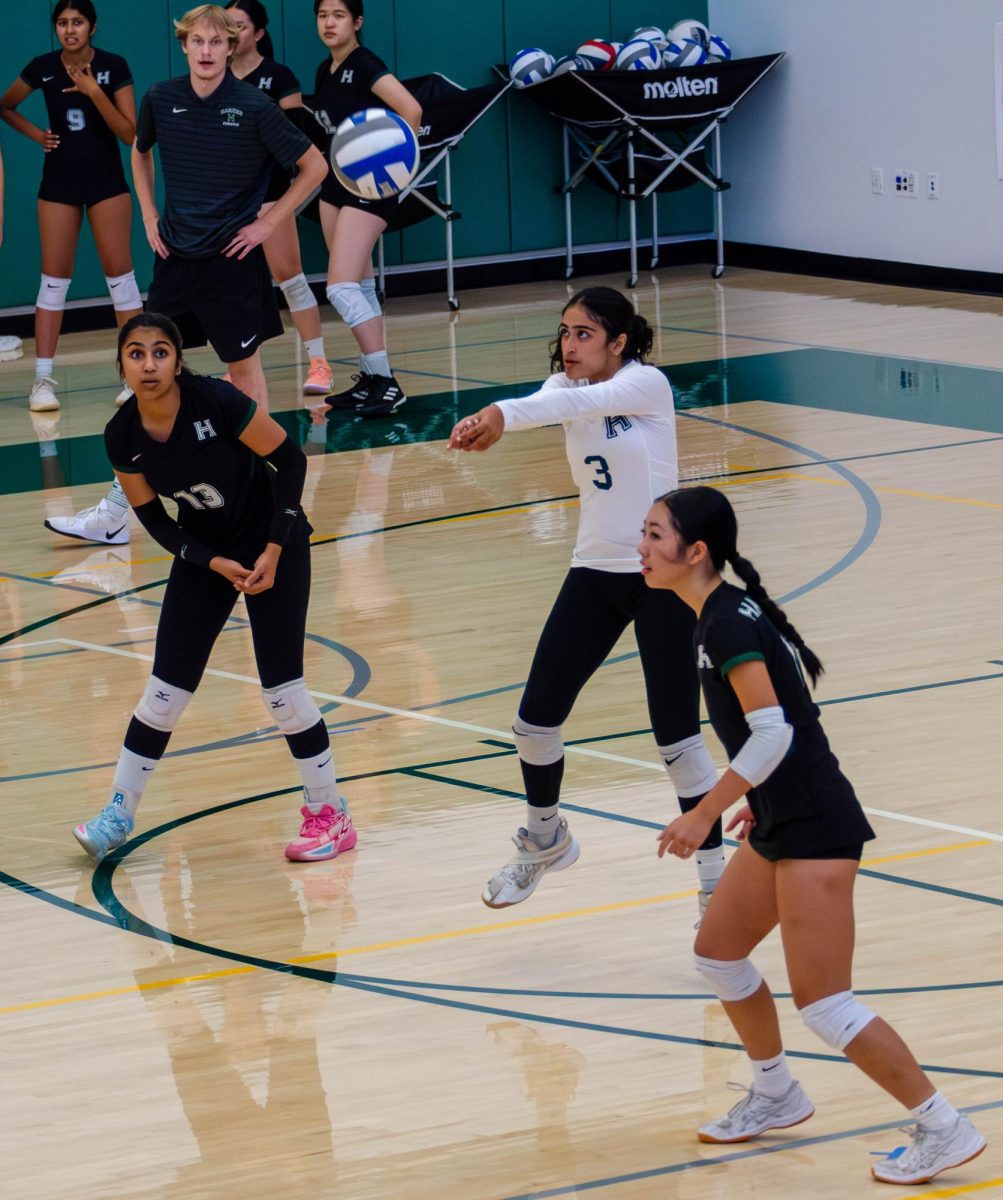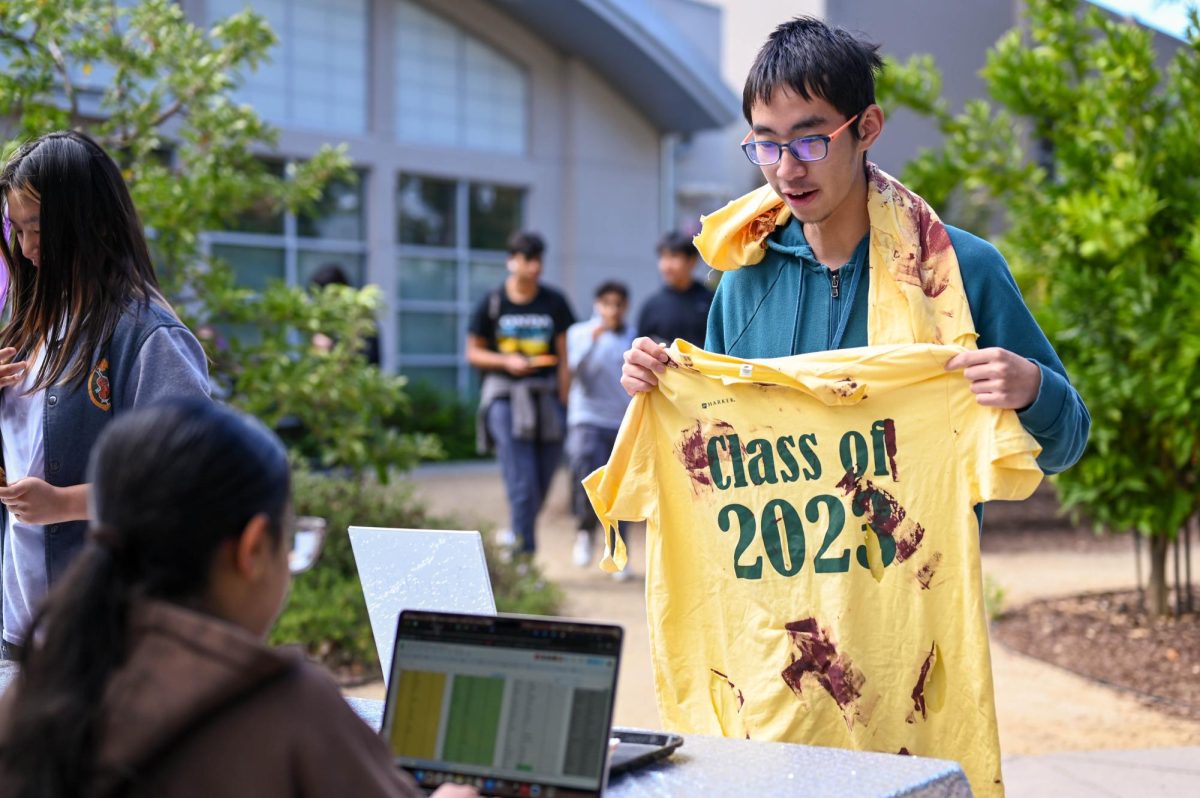Annual Research Symposium features Artificial Intelligence and Virtual Reality Theme
Attendees visit corporate booths in the Nichols Atrium. The annual Harker Research Symposium was held on Saturday.
April 16, 2017
The Women in STEM (WiSTEM) club held the annual Research Symposium, themed Artificial Intelligence and Virtual Reality, this Saturday from 9 a.m. to 5 p.m. at the upper school, spanning from Nichols to Manzanita Hall. The Symposium featured keynote speeches, talks by student researchers, poster sessions by middle and upper school students, interactive displays by corporations, panels and workshops. There were around 815 participants pre-registered to attend the event.
This year, WiSTEM invited Dr. Fei-Fei Li, the director of the Stanford Artificial Intelligence Lab; Dr. Archin Bhowmik, the VP/GM of Perceptual Computing Group and Evan Maynard (‘09), an aerospace engineer at Blue Origin to be the keynote speakers.
Li, who delivered the opening keynote speech, gave a talk on machine learning and computer vision, while also highlighting the lack of diversity within STEM and, in particular, artificial intelligence (AI).
“I think a combination of culture, tradition, and a lack of humanistic and mission-driven education and advocacy all result in a lack of diversity in STEM and AI today,” Li said.
Student researchers, many of whom placed in various science competitions, wer alsoe invited to speak about their projects. Each assigned a specific room and time slot, they prepared a brief presentation, followed by a Q&A session with the audience.
“Especially in health and medicine, I think that data can play a big role in redefining the way that doctors treat patients,” said Regeneron STS finalist Arjun Subramaniam (12), who presented a formal talk on his project involving building a machine learning model to improve the binding efficiency of antibody therapies. “For example, when a patient goes away from the doctor for six months, monitoring their condition through data and using machine learning to diagnose them can allow doctors [to] figure out what’s the best way to treat them. I think that AI has a lot of potential for actually revolutionizing how we treat patients and how we essentially address diseases as well.”
As the organizers of the event, members of WiSTEM club attended the event the day of, coordinated events and manned various stations.
“We had a lot of club meetings, and we basically planned everything early so as to ensure the best experience for everyone,” WiSTEM public relations officer Jacqueline He (11) said. “A few of the things that went into planning include coordinating speakers, arranging activities, and soliciting student speakers. Also, we basically planned everything about the symposium, and of course Ms. Chetty also helped. She did a really large portion of the work.”
WiSTEM chose this year’s theme by examining the technological trends that were prevalent in the Silicon Valley, both in research and in the corporate realm.
“Silicon Valley is extremely computer science-based, it has its roots in computer science – that’s how it was forged as a society,” Jacqueline said. “AI is one of the frontiers of computer science – it’s a super hot topic for research, and there’s so much interest, not only in the science projects that we see this year, but also within the real world professions themselves. We thought it was an extremely relevant topic, which is how we chose AI.”
Anita Chetty, adviser to the WiSTEM club and the Upper School science department chair, further explained the relevance of AI as this year’s theme.
“I’m always looking for what’s cutting edge,” Chetty said. “I try to work in elements within the symposium itself of themes that I think are important, but I really think that we need, if we want this to be a true science research conference, to be taking a look at where the dramatic innovation is happening.”
As the main organizer for the Symposium event, Chetty sees the conference as a unique opportunity to allow multiple generations of individuals interested in science research to come together and learn and inspire each other.
“I really believe that it’s important for people to interact, to engage, for there to be a meeting of the minds,” Chetty said. “It’s really important to me that young children be mentored by older students, older students by adults who have been there, so it’s sort of like there’s this long journey that starts when you’re really young.”
Further, Chetty believes that the personal, interactive element of the conference is what sets it apart and provides a unique learning opportunity.
“Philosophically, as an educator, whether it’s science or anything else, I really believe that it’s people, that human element, that really shapes your future,” Chetty said. “I really believe that, even though education more and more is relying on technology, I don’t think you can ever take away one human talking to another human and teaching them something.


















![“[Building nerf blasters] became this outlet of creativity for me that hasn't been matched by anything else. The process [of] making a build complete to your desire is such a painstakingly difficult process, but I've had to learn from [the skills needed from] soldering to proper painting. There's so many different options for everything, if you think about it, it exists. The best part is [that] if it doesn't exist, you can build it yourself," Ishaan Parate said.](https://harkeraquila.com/wp-content/uploads/2022/08/DSC_8149-900x604.jpg)




![“When I came into high school, I was ready to be a follower. But DECA was a game changer for me. It helped me overcome my fear of public speaking, and it's played such a major role in who I've become today. To be able to successfully lead a chapter of 150 students, an officer team and be one of the upperclassmen I once really admired is something I'm [really] proud of,” Anvitha Tummala ('21) said.](https://harkeraquila.com/wp-content/uploads/2021/07/Screen-Shot-2021-07-25-at-9.50.05-AM-900x594.png)







![“I think getting up in the morning and having a sense of purpose [is exciting]. I think without a certain amount of drive, life is kind of obsolete and mundane, and I think having that every single day is what makes each day unique and kind of makes life exciting,” Neymika Jain (12) said.](https://harkeraquila.com/wp-content/uploads/2017/06/Screen-Shot-2017-06-03-at-4.54.16-PM.png)








![“My slogan is ‘slow feet, don’t eat, and I’m hungry.’ You need to run fast to get where you are–you aren't going to get those championships if you aren't fast,” Angel Cervantes (12) said. “I want to do well in school on my tests and in track and win championships for my team. I live by that, [and] I can do that anywhere: in the classroom or on the field.”](https://harkeraquila.com/wp-content/uploads/2018/06/DSC5146-900x601.jpg)
![“[Volleyball has] taught me how to fall correctly, and another thing it taught is that you don’t have to be the best at something to be good at it. If you just hit the ball in a smart way, then it still scores points and you’re good at it. You could be a background player and still make a much bigger impact on the team than you would think,” Anya Gert (’20) said.](https://harkeraquila.com/wp-content/uploads/2020/06/AnnaGert_JinTuan_HoHPhotoEdited-600x900.jpeg)

![“I'm not nearly there yet, but [my confidence has] definitely been getting better since I was pretty shy and timid coming into Harker my freshman year. I know that there's a lot of people that are really confident in what they do, and I really admire them. Everyone's so driven and that has really pushed me to kind of try to find my own place in high school and be more confident,” Alyssa Huang (’20) said.](https://harkeraquila.com/wp-content/uploads/2020/06/AlyssaHuang_EmilyChen_HoHPhoto-900x749.jpeg)











